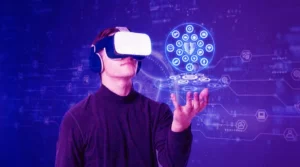ArdorComm- Higher Education and EdTech Conclave & Awards #HEETsouth #HEETbengaluru
We are in the midst of a significant social and economic transformation, fuelled by incredible developments in automation and artificial intelligence, as well as unprecedented data and computation access. These technologies have an impact on practically every sector of our economy, including healthcare, banking, transportation, energy, manufacturing, and many other occupations. These advancements, like earlier industrial revolutions, have the potential to deliver enormous advantages to society and, in the long term, contribute to massive prosperity. Innovations will also change the future of labour, increase skill bias from previous decades, and contribute to a widening gap between the best and the least educated in society. To make the learners adaptable and aligned to the industry needs, it is the need of the hour to re-imagine the higher education in the 21st century workplace by focusing on expanding the boundaries of education, skill and employability. ArdorComm Media Group, as one of India’s fastest-growing media companies, is here to explore the prospects of educational innovation, future trends, and the existing scenario in order to stimulate important discussions among significant education, technology, and government stakeholders. Chandan Anand, Founder, CEO & Group Editor of ArdorComm Media says, “While some professions will be mechanised and others will be drastically altered as a result of technological advancements, we equally realise that new markets, sectors, and employment will emerge, some of which we cannot possibly envision today. Individuals at all stages of their careers should view learning as a lifetime endeavour in today’s fast-paced industry. We need to know what changes should higher education and its stakeholders do to ensure that the workforce has the core competencies and abilities it needs today and in the future?” To address these issues and discuss the desideratum in the Higher education sector, ArdorComm Media, is coming up with the ‘HIGHER EDUCATION and EDTECH CONCLAVE & AWARDS 2022’ #HEETsouth #HEETbengaluru as a ‘PHYSICAL EVENT’ in Bengaluru on 15th July 2022. As new sectors emerge and existing ones expand and collapse dramatically, the skills required to keep up are changing at a faster rate than ever before. Educators and higher education administrators must approach skill competency with a growth mindset that will assist students throughout their careers and in the global knowledge-based economy. There is an apparent need to educate the next generation about rising digital capabilities and how to create, build, and properly use technology. At the same time, students in the 21st century must learn how to approach challenges from several viewpoints, foster and use creativity, communicate effectively, and use critical thinking. These non-automatable “human” abilities are vital in a future of work that is continually evolving, and their value will only increase as automation becomes more prevalent. About the event: The ‘ArdorComm – Higher Education and Edtech Conclave & Awards 2022’ #HEETsouth #HEETbengaluru will grace the floor on 15th July 2022 in Bengaluru, Karnataka. The Summit’s theme will focus on “Re-imagining Higher Education in 21st Century Workplace: Expanding boundaries of Education, Skill and Employability.” The 5 States of South India, Karnataka, Telangana, Andhra Pradesh, Tamil Nadu and Kerala are known for their breathtaking and mesmerizing scenic beauty, vibrant and rich tradition & culture. Along with this, the Higher Education in the southern region is one of the largest & fastest growing education systems in India. Strong governance policy, academic & physical infrastructure, and financial resources have played an active role in improving the quality of teaching, learning & employability outcomes. Literacy rates and per-capita income are much better in southern states. This is the reason why the students and parents get attracted to seek education and opt for careers in the South. This Knowledge forum invites Higher Education Leaders, Innovators and Edtech Experts to share their experiences, ideas and accomplishments which have helped the growth of the education community during the tough times of COVID-19 pandemic. The prestigious ArdorComm Higher Education Awards, EdTech Awards & Edu Startup Awards 2022 aims to acknowledge those Individuals, Educational Institutions, EdTech & Startups who have been tirelessly and fiercely working for the betterment of the Education Community. Key Discussion Points of ‘ArdorComm – Higher Education and Edtech Conclave & Awards 2022’ #HEETsouth #HEETbengaluru :- How technology partnerships and planned financial planning can better the R&D and Digital Infrastructure of a campus? What’s better for today’s Ideal University Education? Multi-disciplinary or e-learning adaptability? How can blended learning change the dynamics of the teacher-student relationship? How can exposure to New Age Technologies help in fostering Experiential Learning Pedagogy? Key Highlights of ‘ArdorComm – Higher Education and Edtech Conclave & Awards 2022’ #HEETsouth #HEETbengaluru:- Panel Sessions: 5 Industry Speech: 7 Speakers: 40+ Government Dignitaries: 10+ Higher Education Institutes (Universities + Engineering Institutes + B-Schools): 150+ Edu Corporate: 10+ Edtech Startups: 10+ ‘ArdorComm – Higher Education and Edtech Conclave & Awards 2022’ #HEETsouth #HEETbengaluru awaits your response to collaborate with many more leading stakeholders from different higher education and tech sectors. Join the Education Conclave to be a part of a community that cares deeply about imparting education. Witness the change taking place when India’s top educators, innovators and dignitaries come together to share their best practices and views. Let’s vow to be the game-changers in the education community in 2022. Inviting you to participate & witness the ‘ArdorComm- Higher Education and Edtech Conclave & Awards 2022’ #HEETsouth #HEETbengaluru on 15th July 2022 in Bengaluru, Karnataka.
ArdorComm- Higher Education and EdTech Conclave & Awards #HEETsouth #HEETbengaluru Read More »










